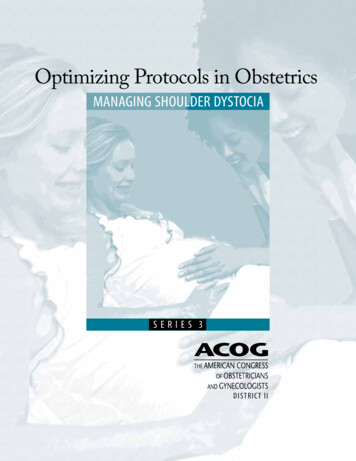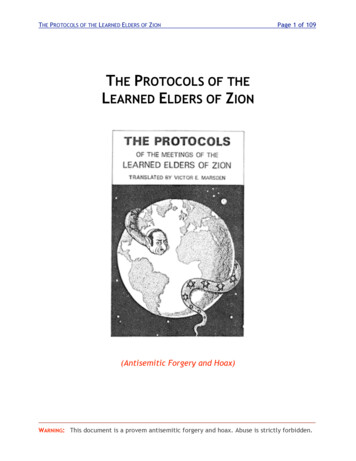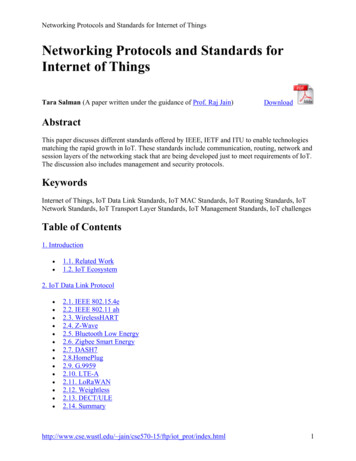
Transcription
Optimizing Protocols in ObstetricsMANAGING SHOULDER DYSTOCIASERIES 3DIS TRIC T II
Optimizing Protocols in ObstetricsSERIES 3JULY 2013Index: Series 3PAGE34NURSING INTERVENTIONSExecutive SummaryKey Elements for Managing Shoulder DystociaACOG PUBLICATIONS9112Patient Safety Checklist # 6: Documenting Shoulder Dystocia (August 2012)Committee Opinion # 487:Preparing for Clinical Emergencies in Obstetrics and Gynecology
Optimizing Protocols in ObstetricsSERIES 3JULY 2013Key Elements for Managing Shoulder DystociaExecutiveSummarySixteen hospitals throughout New York State responded to a request from ACOG District II to submittheir written protocols regarding the management of shoulder dystocia. Although many containedexcellent educational and instructional components, the committee did not identify a single protocolNURSING INTERVENTIONSthat could meet the needs of all hospitals in New York State.Most of the submitted protocols lacked a systematic approach required to ensure an effective guidelineor protocol. However, the District II Patient Safety Committee was able to identify key elements andmodel protocol language from four hospitals which may be useful as hospitals strive to further improvetheir shoulder dystocia protocols. The committee has chosen and enclosed protocol language fromArnot Ogden Medical Center, Nathan Littauer Hospital and Winthrop University Hospital.The protocols should reflect current criteria used to manage deliveries at risk for or complicated byshoulder dystocia and should outline the treatment and maneuvers required during an emergencyof shoulder dystocia. In addition to reviewing the submitted protocols, the committee used severalresources to select ideal requirements for a comprehensive approach to the management of shoulderdystocia. Two of these included:1. ACOG Practice Bulletin 40, Shoulder Dystocia (reaffirmed 2010)2. ACOG Checklist for Documenting Shoulder Dystocia No. 6 (August 2012)It is important that obstetrician-gynecologists take the lead in designing and collaboratively implementing standardized protocols and checklists in the hospital and the office setting. Each hospitalmust take into account the resources available within its own institution and community to designa protocol that will assist them in the optimal management of shoulder dystocia. Each institutionis strongly encouraged to review its existing shoulder dystocia protocols, and modify them if necessary to maximize safe patient care, or if none exists consider the creation of a policy to optimizethe management of shoulder dystocia.Key ElementsThe following is a list of the essential components of any protocol that is developed for the managementof shoulder dystocia. Hospitals should individualize their protocols based on an assessment of theirown resources. Definition & Risk FactorsMonitoring & Pre-Delivery PreparationsDiagnosis & Protocol InitiationElements of the ProtocolDebriefingDocumentationMedical literature demonstrates that when there are inadequate hospital protocols or there is a lack ofconsistent diagnosis, management, consultation, and/or referral, confusion and unnecessary variationin patient care may result.3
Optimizing Protocols in ObstetricsSERIES 3JULY 2013Key Elements for Managing Shoulder DystociaPurposeThis document reflects emerging clinical, scientific and patient safety advances as of the date issued andis subject to change. The information should not be construed as dictating an exclusive course of treatment or procedure to be followed. While the components of the protocols included in this docuNURSING INTERVENTIONSment may be utilized as written, it is strongly recommended that they be reviewed in detail andadapted to local resources available within an institution as well as being modified if appropriate.Variations in practice may be warranted based on the needs of the individual patient, resources,and limitations unique to the institution.Clearly explain the purpose of the protocol. The protocol should reflect current criteria used to managedeliveries at risk for or complicated by shoulder dystocia and should outline the treatment and maneuvers required during an emergency of shoulder dystocia.ReferencesDefinition &Risk FactorsPermission to utilizesample protocollanguage obtainedfrom:Winthrop UniversityHospital:Guidelines forShoulder Dystocia;Nursing ProcedureManual (2010) The American College of Obstetricians and Gynecologists. “Shoulder Dystocia”.ACOG Practice Bulletin 40. Reaffirmed 2010.ACOG Checklist for Documenting Shoulder Dystocia, Number 6. August 2012.Shoulder dystocia is an event that occurs at delivery. Extra difficulty delivering fetal shoulders is encountered, requiring extra maneuvers.Shoulder dystocia complicates 0.6 to 1.4% of vaginal deliveries of fetuses in the vertex presentation.Unfortunately, shoulder dystocia cannot be predicted or prevented because accurate methods for identifying which fetuses will experience this complication do not exist. Elective induction of labor or elective cesarean delivery for all women suspected of carrying a fetus with macrosomia is not appropriate.Planned cesarean delivery to prevent shoulder dystocia may be offered for suspected fetal macrosomiawith estimated fetal weights exceeding 5000 gm in women without diabetes and 4500 gm in those withdiabetes.Risk Factors associated with Shoulder dystocia:MaternalAbnormal pelvic anatomySuspected macrosomiaLabor RelatedOperative vaginal deliveryGestational or Pre-GestationalDiabetesProtracted active phasePost-term pregnancyProlonged second stagePrevious shoulder dystociaPrecipitous deliveryShort stature (less than 5feet tall)Obesity ( 200lbs)Previous large infant( 4000grams)Excessive weight gain4Fetal
Key Elements for Managing Shoulder DystociaMonitoring &Pre-DeliveryPreparationsEnsure adequate personnel are present in the delivery room.1. Experienced care provider2. Two labor and delivery nursesPermission to utilizesample protocollanguage obtainedfrom:Ensure that the bed is in a lowered position or a stool is available to assist with specific maneuvers.Arnot OgdenMedical Center:Management ofthe patient with asuspected shoulderdystocia (1999)Nathan LittauerHospital &Nursing Home:Shoulder DystociaProtocol (2009)Notify, NICU neonatologist, and anesthesiologist if the shoulder dystocia is suspected.The care provider should discuss with the nursing personnel the sequence and maneuvers that mightbe performed.Remember the mnemonic BE CALM, which outlines interventions for the nurse and provider, andstands for:Breathe, do not push. Lower the head of the bed and encourage the woman to breathe or pant.Elevate the legs into McRobert’s position. McRoberts Maneuver (knee/chest position whilesupine) is hyperflexion and abduction of the maternal hips. This procedure straightens the lumbarsacral angle and rotates the symphysis pubis anteriorly to dislodge the anterior shoulder.Call for help. Initiate OB emergency plan; includes, but not limited to, the following: Additional nursing staff (prepare for newborn resuscitation)Physician able to perform c-sectionAnesthesia providerPediatric providerRespiratory therapy (assist with newborn resuscitation).Apply suprapubic pressure (NOT fundal pressure).EnLarge the vaginal opening. Provider may perform a large episiotomy when additionalmaneuvers are necessary to allow for more room.Maneuvers— additional maneuvers may be needed (and are performed by the (LicensedIndependent Practitioner) and listed below: Delivery of the Posterior Arm Woods Corkscrew Rubin Gaskin ZavanelliThese maneuvers are designed to rotate the baby NOT to pull on the shoulders, which mayresult in birth trauma.Nurse audibly signals each one (1) minute interval after delivery of fetal head (due todecreasing fetal pH of 04. per minute, making resuscitation very difficult after seven (7) minutes.CAUTION: NEVER USE FUNDAL PRESSURE.5
Key Elements for Managing Shoulder DystociaDiagnosis &ProtocolInitiation1. “Turtle sign” retraction of the fetal head against the maternal perineum.2. Difficulty or failure to accomplish external rotation of the head after it has passedthe perineum.3. Resistance to the delivery of the anterior shoulder with the usual amount of tractionapplied to the fetal head.Elements ofthe ProtocolSTEP 1. Inform those in the room of the clinical condition and ask for cooperation;call for assistant to help with the delivery; ask that Anesthesiology and Neonatologyshould be summoned into the room.Have someone note the exact time and signal each minute of time that passes. Avoidforceful downward traction on the fetal head while attempting to deliver the infant.Fundal pressure is not useful and is counterproductive.Communicate with those in the room (charge nurse; float nurse; patient, and family).Clear the room of all unnecessary items and have a step stool available.Ensure the patient’s bladder is empty.STEP 2. First Line Maneuvers: First line maneuvers may be done alone, in combination, or insequence.McRobert’s Maneuver: Have assistants sharply flex the patient’s legs against the abdomen(this results in straightening of the sacrum relative to the lumbar vertebrae with a cephalicrotation of the pelvis).Suprapubic Pressure: Have an assistant apply a moderate suprapubic pressure obliquely tothe anterior shoulder (This may help to dislodge the impacted anterior shoulder).Episiotomy: If not performed previously, perform generous episiotomy or extendexisting episiotomy as needed and repeat McRobert’s maneuver and suprapubic pressure(although the perineum is not the cause of the shoulder dystocia, an episiotomy canfacilitate the performance of subsequent maneuvers and delivery).6
Key Elements for Managing Shoulder DystociaElements ofthe Protocol(Continued)STEP 3. Second Line Maneuvers: May be done in any sequence according to need.Delivery of the Posterior Arm: Introduce a hand into the vagina along the fetal posteriorhumerus; maintain flexion at the elbow and sweep the arm across the fetal chest; the fetalhand is then grasped and the arm extended along the side of the face; the posterior arm isthen delivered from the vagina (mechanism: the shoulders are rotated into an oblique diameter and subsequent delivery of the anterior shoulder and infant may be completed).Woods Corkscrew Maneuver: Place a hand behind the posterior shoulder and rotate theposterior shoulder 180 degrees (this rotation will “corkscrew” the fetus out of the vagina).Photograph from Williams Obstetrics, 21st Edition.Copied with the permission of The McGraw-Hill Companies, Inc.Rubin Maneuver: Place a hand on the most easily accessible shoulder and push the shoulder toward the anterior surface of the fetal chest (this may result in abduction of both fetalshoulders and decrease the shoulder to shoulder dimension freeing the impacted anteriorshoulder).Photograph from Williams Obstetrics, 21st Edition.Copied with the permission of The McGraw-Hill Companies, Inc.Repeat first and second line maneuvers if the infant remains undelivered (repeating the maneuvers, listed in step 2 and 3 should be tired before proceeding to the following extraordinarymaneuvers).Note: There is no conclusive evidence that any particular management sequence is superiorto another once the shoulder dystocia occurs. However, performance of McRobert’s maneuver is a reasonable initial approach.7
Key Elements for Managing Shoulder DystociaElements ofthe ProtocolSTEP 4. Extraordinary ManeuversLast effort maneuvers that only should be used when the above steps are unsuccessful.Fracture of the clavicle: Deliberate fracture of the clavicle may be accomplished by pressing the anterior clavicle against the ramus of the pubis. Fractures of the clavicle usually healrapidly without permanent sequelae.(Continued)Cephalic replacement: (Zavanelli maneuver) return the fetal head to the OA or OP position;flex the fetal head and slowly push it back into the vagina. Uterine relaxation may be requiredfor this maneuver, which is followed by emergency cesarean section.Abdominal rescue: If all maneuvers fail and unable to replace the fetal head into the vagina,a cesarean section can be performed to manually rotate the anterior shoulder into the obliquediameter; vaginal delivery is then accomplished (this results in a prolonged head-to-deliveryinterval and requires two skilled delivery attendants).Symphysiotomy: This should only be performed by individuals who have knowledge andexperience in this procedure.DebriefingDocumentationFollowing delivery, staff should debrief, analyze their actions, and confirm consistent documentationbetween nursing and practitioner notes. Debriefing helps to ensure accurate and complete documentation and that there are not disparate notes from the practitioners and the nurses. Use of a standardizedform and/or checklist for shoulder dystocia delivery notes may provide the best solution to ensure appropriate documentation.qType of delivery (spontaneous vs. instrumental)If instrumental, type of instrument, station and indicationqqqqqqqqqqAnterior shoulder (right or left)Medication/anesthesia givenTime of delivery of head and bodyManeuvers used- sequence and duration of eachEpisiotomy— type and timeTraction on vertex (none or standard)Personnel presentCondition of the infant— Apgar scores, evidence of fractures and/or reduced movementof either armCord gasses sentInformation given to the patient and her family* Refer to the enclosed ACOG Patient Safety Checklist Documenting Shoulder Dystocia, Number 6August 20128
Patient Safety Checklist Number 6 August 2012Documenting Shoulder DystociaDate PatientDate of birth MR #Physician or certified nurse–midwife Gravidity/ParityTiming:Onset of active laborStart of second stageDelivery of headTime shoulder dystocia recognized and help calledDelivery of posterior shoulderDelivery of infantAntepartum documentation: Assessment of pelvis History of prior cesarean delivery: Indication for cesarean delivery: History of prior shoulder dystocia History of gestational diabetes Largest prior newborn birth weight Estimated fetal weight Cesarean delivery offered if estimated fetal weight greater than 4,500 g (if the patient has diabetes mellitus)or greater than 5,000 g (if patient does not have diabetes mellitus)Intrapartum documentation: Mode of delivery of vertex: Spontaneous Operative delivery: Indication: Vacuum Forceps Anterior shoulder: Right Left Traction on vertex: None Standard No fundal pressure applied Maneuvers utilized (1): Hip flexion (McRoberts maneuver)Delivery of posterior armPosterior scapula (Woods maneuver)Abdominal delivery Suprapubic pressure (stand on the side of the occiput)All fours (Gaskin maneuver)Anterior scapula (Rubin maneuver)Zavanelli maneuver Episiotomy: None Median Mediolateral Proctoepisiotomy Extension of episiotomy: None Third degree Fourth degree Laceration: Third degree Fourth degree Cord blood gases sent to the laboratory: Yes: Results: No430VOL. 120, NO. 2, PART 1, AUGUST 2012(continued)OBSTETRICS & GYNECOLOGY
(continued) Status of neonate prior to leaving delivery room or operating room:Apgar scoresEvidence of injuryBirth weight (if available) Staff present Family members present Patient and family counseled Debriefing with appropriate personnelPostpartum/neonatal documentation: Delivery discussed with family Perineal assessment if third or fourth degree laceration Monitored for postpartum hemorrhage: Yes: Results: No Communication with pediatrics department if there is evidence of injury or asphyxia Coordination of follow-up care for mother and baby Monitored for postpartum depression: Yes: Results: NoProcedural Elements for Shoulder DystociaThe following steps should be taken when managing shoulder dystocia:1. Call for help from pediatrics, anesthesia, and neonatal intensive care unit staff, and assign a timekeeper2. Initiate maneuver (eg, McRoberts maneuver)3. Re-evaluate course of actions, including using other maneuvers or repeating maneuvers if unsuccessful4. Consider abdominal delivery5. Document event—move to documentation checklistReference1. Shoulder dystocia. ACOG Practice Bulletin No. 40. American College of Obstetricians and Gynecologists. Obstet Gynecol2002;100:1045–50.Standardization of health care processes and reduced variation has been shown to improve outcomes and quality of care. The American College of Obstetricians and Gynecologists has developeda series of Patient Safety Checklists to help facilitate the standardization process. This checklistreflects emerging clinical, scientific and patient safety advances as of the date issued and is subjectto change. The information should not be construed as dictating an exclusive course of treatment orprocedure to be followed. Although the components of a particular checklist may be adapted to localresources, standardization of checklists within an institution is strongly encouraged.How to Use This ChecklistThe Patient Safety Checklist on Documenting Shoulder Dystocia should be used to guide the documentation processif a patient has experienced shoulder dystocia.Copyright August 2012 by the American College of Obstetricians and Gynecologists, 409 12th Street, SW, PO Box 96920,Washington, DC 20090-6920. All rights reserved. No part of this publication may be reproduced, stored in a retrieval system, postedon the Internet, or transmitted, in any form or by any means, electronic, mechanical, photocopying, recording, or otherwise, without prior written permission from the publisher. Requests for authorization to make photocopies should be directed to: CopyrightClearance Center, 222 Rosewood Drive, Danvers, MA 01923, (978) 750-8400.Documenting shoulder dystocia. Patient Safety Checklist No. 6. American College of Obstetricians and Gynecologists. ObstetGynecol 2012;120:430–1.VOL. 120, NO. 2, PART 1, AUGUST 2012Patient Safety ChecklistDocumenting Shoulder Dystocia431
The American College of Obstetricians and GynecologistsWomen’s Health Care PhysiciansCommiTTee opinionNumber 487 April 2011(Replaces No. 353, December 2006)Committee on Patient Safety and Quality ImprovementThis document reflects emerging concepts on patient safety and is subject to change. The information should not be construed as dictating an exclusive course of treatment or procedure tobe followed.Preparing for Clinical Emergencies in Obstetricsand GynecologyABSTRACT: Patient care emergencies may periodically occur at any time in any setting, particularly theinpatient setting. To respond to these emergencies, it is important that obstetrician–gynecologists prepare themselves by assessing potential emergencies that might occur, creating plans that include establishing early warningsystems, designating specialized first responders, conducting emergency drills, and debriefing staff after actualevents to identify strengths and opportunities for improvement. Having such systems in place may reduce orprevent the severity of medical emergencies.A practicing obstetrician–gynecologist may be faced witha sudden patient emergency at any time. Whether it issevere shoulder dystocia, catastrophic surgical or obstetrichemorrhage, or an anaphylactic reaction to an injectionin the office, it will require prompt response. Preparationfor potential emergencies requires planning. Issues toconsider include advance provisioning of resources,establishing an early warning system, designating specialized first responders, and holding drills to ensure thateveryone knows what to do in an emergency. Beyondthese basics, certain principles of communication andteamwork will increase the efficiency and effectiveness ofthe emergency response.PlanningPlanning for potential emergency events is challenging.At a minimum, it should involve an assessment of thepotential or actual risks related to the practice setting orthe patient population. For example, in the outpatientsetting, are medications given or procedures performedthat may result in anaphylaxis, airway compromise, orhemorrhage? In the inpatient setting, unit data or riskmanagement data may reflect common and uncommonemergency situations that have occurred.Advance Provision of Resources in theOutpatient SettingA common practice for health care–related emergenciesis the availability of the crash cart. All physicians should1032VOL. 117, NO. 4, APRIL 2011be familiar with the crash cart. Placing all necessary itemsin a known, central location ensures that time is not lostgathering supplies in an emergency. Appropriate changesshould be made to the crash cart as evidence-basedchanges are made to the Advanced Cardiac Life Supportprotocol. Advance provision of resources also may beextended, for example, to the management of eclampsiaand malignant hyperthermia. Physicians in outpatientsettings may wish to create a small kit for handling allergicreactions if they are not able to maintain a full crash cart.As with a crash cart, the kit must be checked regularly toensure that perishable supplies have not been retainedbeyond expiration dates. All health care providers need toknow how to use the allergic reaction kit.Early Warning Systems in theInpatient SettingSome emergencies are truly sudden and catastrophic, suchas a ruptured aneurysm, massive pulmonary embolus, orcomplete abruptio placentae in the setting of trauma.However, many emergencies are preceded by a periodof instability during which timely intervention may helpavoid disaster. The rapid response team is set up to handlesuch emergencies. However, even without the use of arapid response team, nurses and other bedside caregiversneed to recognize that certain changes in a patient’s condition can indicate an emergency that requires immediate intervention. These changes include some events notusually considered to be emergencies, such as agitation orOBSTETRICS & GYNECOLOGY
new onset difficulty with movement. Ideally, each servicewill examine its own historical call data to determinewhich events require activation of the early warningsystem. It is imperative that bedside personnel be ableto request immediate help, without recrimination, whensuch changes occur. For example, the nurse who callsthe rapid response team regarding the anxious postoperative patient with new onset shortness of breath mustnot be dismissed as failing to recognize a panic attackbut instead praised for following protocol. The protocolshould provide for a full evaluation of the problem. Someorganizations have formalized the emergency communication process using a standardized communication tool,such as “SBAR” (Situation, Background, Assessment, andRecommendation); all health care providers are encouraged to follow it to clearly communicate the patient careissue. Standardized responses will increase the efficiencyof care and allow a continuous quality improvement process to assess the effectiveness of the interventions.Rapid Response TeamMedical emergency teams, otherwise known as rapidresponse teams, are designated emergency responseteams. These teams of clinicians bring critical care expertise to the patient’s bedside or wherever it is needed.Activation of rapid response team intervention occurswhen predefined criteria are met, although the teamintervention also may be activated for other reasons.Rapid response team intervention should be a no-faultprocess. The team is available at all times with authority to summon further help as needed. By designatingcriteria that define an emergency, it becomes clear whento call for help. For example, if a maternal or postoperative heart rate of more than 140 beats per minute is thecriterion, the nurse who notes such a heart rate wouldimmediately call the medical emergency team. Thiscontrasts with the common practice of calling an attending physician and awaiting a call back for orders beforeintervention. Activation of rapid response team intervention before a full arrest may lead to improved survivalof hospitalized patients and decreased admissions to anintensive care unit (1). It is important to emphasize thatif there is a teaching service, calling the house officerdoes not substitute for triggering rapid response teamintervention. Similarly, calling the in-house physicianin a nonteaching setting does not substitute activatingrapid response team intervention. Rapid response teamsusually have advanced practice nurses and respiratorytherapists as first responders and are expected to respondto the problem in a standardized fashion.The goal of standardized response and rapid effective recognition and correction of problems is bettermet with a small stable group. Development of a rapidresponse system is one of the patient safety initiativescurrently being promoted by the Institute for HealthcareImprovement (2) and the Agency for Healthcare Researchand Quality. Blueprints for setting up such a system, asVOL. 117, NO. 4, APRIL 2011well as other resources, may be found on the web sites ofthese organizations.Establishing a rapid response system involves a multistep process (3–5). First, key staff must be identified forthe response team. Second, the criteria for activation ofintervention by the response team should be determined.Third, the staff involved with the rapid response systemmust be educated on their respective roles. Fourth, ameans of evaluating feedback and process improvementmust be established. Finally, the effectiveness of the rapidresponse system must be monitored. The rapid responsesystem can be divided into four components: 1) activators,2) responders, 3) quality improvement, and 4) administration (6).The activators are those individuals who may activate the rapid response system. Activators may be floorstaff, a patient, a family member, specialists, or anyoneconcerned about the condition of a particular patient.Team members from the nursing staff or floor staff aretrained to monitor for disturbances in any indicators ofacute distress. These indicators are determined by theindividual medical treatment facilities.Once the rapid response system is activated, theresponders arrive at the bedside, along with the attendingphysician, to treat the patient and stabilize her condition.Responders will then determine the disposition of thepatient. Options for this can include transfer to a higherlevel of care, a handoff to the primary team (nurse orphysician or both), or revision of the current treatmentplan. Activators may become responders to help aid instabilizing the patient’s condition.When the responders arrive, the activators must beprepared to exchange information. A communication protocol such as SBAR may be used. Using such a protocolallows the activators to exchange information with theresponders in a clear and concise manner. This will helpensure that expeditious care is provided to the patient.During the response phase, other tools may beimplemented to help facilitate care for the patient. Beforeinitiation of the response phase, a discussion, or brief,should be conducted to assign essential roles, establishexpectations and climate, and anticipate outcomes andlikely contingencies. The primary purpose of the communication protocol is to develop a common understandingof the patient’s issues so that a consensus for the patient’streatment plan can be reached. A team huddle, designedto reinforce plans already in place and to assess the needto adjust the plan, also may be used to review situationalawareness and to troubleshoot and revise the current planof action, if needed. A check back, time out, or call outmay be used to ensure closed-loop communication.The quality improvement team supports activatorsand responders by reviewing the events surrounding theactivation of the rapid response system and evaluating theprocess. An informal information exchange, or debrief, isdesigned to improve team performance and effectivenessas part of the action review. Once the review is complete,Committee Opinion Preparing for Clinical Emergencies1033
the administration team then provides organizationalresources to implement improvements in the process.Emergency Drills and SimulationThe principle that standardized care can result in safe careapplies to emergencies as well as to routine care. Thus,each service should consider a protocol for management of common emergencies, such as emergency cesarean deliveries or postpartum hemorrhage. This trainingmay use a sophisticated simulated environment, but italso may use the everyday workspace in a mock event.Protocols also can be reinforced by being prominentlydisplayed as posters, pocket cards, or other aids.Using drills to train physicians to respond to emergencies has several theoretical advantages. Adult learningtheory supports the importance of experiential learning.Emergencies occur in a specific physical setting and mayinvolve a group of nurses, physicians, and other healthcare providers attempting to respond. By conductinga drill in a realistic simulator or in the actual patientcare setting, issues related to the physical environmentbecome obvious.Emergency drills also allow physicians and others topractice principles of effective communication in a crisis.Many aspects of the medical environment work againsteffective communication, including the often hierarchicalhospital structure, and the nature of the training, worksetting, and the different educational backgrounds andlevels of understanding of the health care team. Manyphysicians are accustomed to talking to nurses. Effectiveteamwork requires talking with each other. It requiresthat there be a team leader coordinating the response,but it also should empower all members of the team toshare information. By practicing together, barriers hindering communication and teamwork can be overcome.Effective drills may lead to improved standardization ofresponse, health care provider satisfaction, and patientoutcomes.Simulator training also may b
1. ACOG Practice Bulletin 40, Shoulder Dystocia (reaffirmed 2010) 2. ACOG Checklist for Documenting Shoulder Dystocia No. 6 (August 2012) It is important that obstetrician-gynecologists take the lead in designing and collaboratively imple-menting standardized protocols and checklists in the hospital and the office setting. Each hospital









![01. Communication Protocols [Read-Only] - GE Grid Solutions](/img/55/commprot.jpg)
